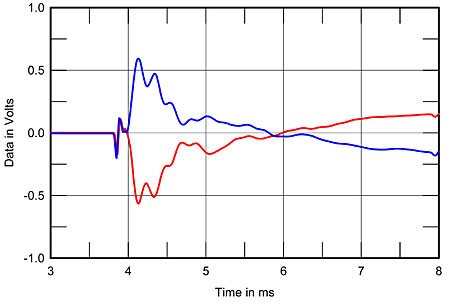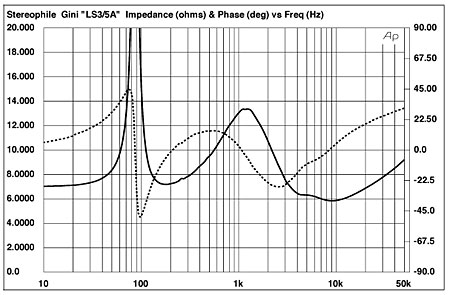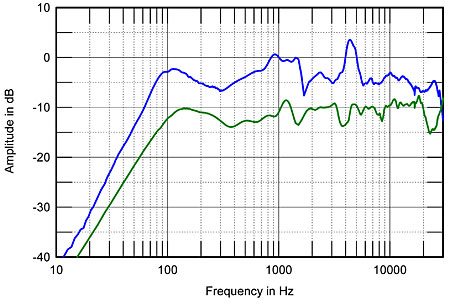| Columns Retired Columns & Blogs |
Gini Systems "LS3/5a" loudspeaker Measurements
Sidebar 2: Measurements
As John Marks writes, he sent me this unauthorized copy of the classic BBC-designed minimonitor to measure because he suspected an internal wiring problem in one of the speakers. This turned out to be the case: as you can see in fig.1, which shows the step responses of both samples, while both speakers had the tweeter wired in inverted acoustic polarity, one speaker also had the woofer wired in negative polarity (red trace) rather than positive (blue trace). Having the woofer and tweeter in the same polarity results in a suckout in the crossover region between the woofer and tweeter, so I rewired the red sample to be the same as the blue one. Before I returned the Ginis to JM for him to finish his report, I took a complete suite of measurements.

Fig.1 Gini Systems LS3/5a, step response on tweeter axis at 50" of samples A (red) and B (blue). (5ms time window, 30kHz bandwidth.)
Assessed with DRA Labs' MLSSA system, the Gini Systems "LS3/5a"'s voltage sensitivity on its tweeter axis is a low 83.5dB(B)/2.83V/m, though this is 1dB higher than the original LS3/5a. Its impedance (fig.2) remains above 8 ohms for much of the audioband, with a minimum value of 5.9 ohms at 9kHz. Like the original, this "LS3/5a" will be an easy load for the partnering amplifier.

Fig.2 Gini Systems LS3/5a, electrical impedance (solid) and phase (dashed). (2 ohms/vertical div.)
Though it will be hard to see at the scale fig.2 is printed in the magazine, there are slight discontinuities in the impedance traces between 250 and 500Hz, suggesting the presence of cabinet resonances. I did find two strong resonances on the rear panel, at 305 and 500Hz (fig.3). The lower-frequency resonance was also very strong on the side panel, and this behavior often leads to a lack of midrange clarity. Indeed, I note that JM found the Gini to add a noticeable chest resonance to Richard Lehnert's spoken introductions to some of the tracks on Stereophile's Test CD 2 (Stereophile STPH004-2).

Fig.3 Gini Systems LS3/5a, cumulative spectral-decay plot calculated from output of an accelerometer fastened to center of side panel (MLS driving voltage to speaker, 7.55V; measurement bandwidth, 2kHz).
The 44-ohm impedance peak at 87Hz tells us that this is the tuning frequency of the sealed-box woofer, which is a little lower in frequency than that of the original speaker. Sure enough, the Gini's bass response, measured in the nearfield, humps up in the upper bass, with a second-order rolloff below 90Hz (fig.4, blue trace). As John Marks suspected, the rise in the bass is also a little more exaggerated than in the real LS3/5a (green trace, offset by –10dB for clarity), which also rolls off a little earlier.

Fig.4 Gini Systems LS3/5a, anechoic response on tweeter axis at 50" with grille, averaged across 30° horizontal window and corrected for microphone response, with the nearfield responses of the woofer plotted below 300Hz (blue); response under identical conditions of 1978 Rogers LS3/5a (green), offset by –10dB.
One of the characteristics of the original BBC speaker was the slight peak between 1 and 2kHz, though the exact height and frequency of this peak varied considerably, depending on the manufacturer and vintage. The Gini speaker has a similar upper-midrange peak, though it is both broader and higher. Of greater concern is the sharp peak centered at 4.3kHz, which I am sure led to JM finding the transition between the Gini's woofer and tweeter to be noticeable with pink noise.
This peak, however, might look worse than it sounds, as the Gini's lateral dispersion (fig.5) has an off-axis suckout in the same frequency region. In the vertical plane (fig.6), the speaker's treble balance changes considerably over a narrow angle above and below the tweeter. More than usual, the Gini owner should experiment with stand height to get the most neutral treble balance.

Fig.5 Gini Systems LS3/5a, lateral response family at 50", normalized to response on tweeter axis, from back to front: differences in response 90–5° off axis, reference response, differences in response 5–90° off axis.

Fig.6 Gini Systems LS3/5a, vertical response family at 50", normalized to response on tweeter axis, from back to front: differences in response 45–5° above axis, reference response, differences in response 5–45° below axis.
Finally, the Gini "LS3/5a"'s cumulative spectral-decay plot, assessed in the farfield, is dominated by two broad ridges of resonant energy, one at the frequency of the on-axis peak and the other at the top of the upper-midrange peak in the on-axis response (fig.7). The former would lead to JM's feeling that there was a "decidedly uncomfortable emphasis" to the sound of cymbals, and though he conjectured that the problem had to do with the tweeter, I feel it is actually the woofer behaving badly at the top of its passband.

Fig.7 Gini Systems LS3/5a, cumulative spectral-decay plot on tweeter axis at 50" (0.15ms risetime).
John Marks wrote that he felt that Gini Systems has made too faithful a copy of the original LS3/5a, but their version seems to me more like an exaggeration of the classic speaker's character. On the other hand, when you consider that modern LS3/5as sell for up to $1995/pair, the Gini is relatively inexpensive.—John Atkinson
- Log in or register to post comments




































